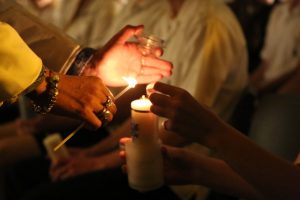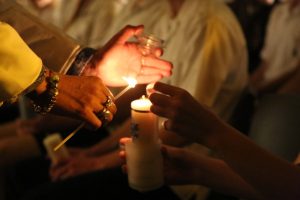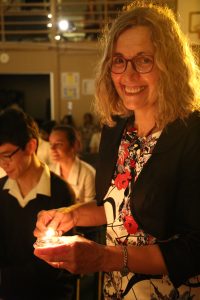
Away in a manger, no crib for a bed.
December 12, 2018
By Anne Armstrong, RE Curriculum Coordinator
As part of Advent preparations, many of you will have put up your Christmas decorations, complete with the Christmas Crib, which is a Franciscan tradition, dating back to 1223. Perhaps you put the figure of the baby Jesus in the manger on Christmas Eve, having contemplated during Advent the Annunciation and devotion of Mary and Joseph to the God who called them to be faithful to each other, their child and their God. Despite the complexity of their circumstances Mary and Joseph seem to live out the command in the Psalms to “Rejoice! . . . The Lord is near. Have no anxiety at all,” They live out the call to be joyful, without fear for the future. Mary herself lives in the angel’s affirmation to not be afraid for she has found favour with God.
In 1223 that first crib was celebrated in the woods of Greccio near Assisi, on Christmas Eve. St Francis had asked a townsman, John (Messier Giovanni Velitta), about two weeks before Christmas to prepare a manger, complete with donkey and ox. Franciscans from various communities, men and women of the neighbourhood, bought candles and torches to brighten the night and celebrated with St Francis.
The word ‘manger’ comes from the French word the French manger (meaning “to eat”), from Latin mandere (meaning “to chew”). It is quite appropriate that during that Christmas celebrations are centred around a festive table, with friends and family gathered from far and wide to honour the season of giving by chewing over the events of the past year with laughter and sometimes tears, but always with thankfulness.

The manger and the Eucharist have both chewing and gratitude in common. The word “Eucharist” means “giving thanks,” but in a Jewish context is directed specifically towards giving thanks to God. At the manger we contemplate the God made flesh and give thanks for his incarnation. At our own family tables are we also conscious of the child whose birth we are celebrating?
This year, as in many years previous, Bethlehem’s Manger Square, traditionally the place of Jesus’ birth, will be transformed by multitudes of pilgrims, eager to honour their saviour and contemplate his incarnation. Perhaps you could be an internet pilgrim this year and view the pilgrimages and service as they occur. You will see a crib, albeit life-size and perhaps a little too gauche.
The manger we contemplate calls us to adore the Christ who will become the bread of life. This manger with its gathering of shepherds and kings, the unschooled and the educated, the unclean and the pure, the believers and the sceptical has become a table around which a great celebration occurs, where dialogue can take place and where real community is lived and nurtured.

The theologian, Patrick Oliver, observes laying the straw in the crib prompts us to remember that Jesus is no stranger to the messy, and soiled, the smelly and the unkempt. After all, the shepherds who came to visit Jesus may have been seen as outcasts. Shepherds were considered unskilled laborers, unclean because they didn’t wash properly and therefore banned from participating in Temple life. The exception to this rule were the shepherds from the eastern plains of Bethlehem. In these plains was the watchtower of Migdal Eder where the Messiah was supposed to be revealed. According to the Mishna, flocks that were pastured there were destined for the temple sacrifices and the shepherds that tended them were the only ones not unclean.
Whether clean or unclean, the shepherds represent the role of the Temple in Jerusalem in the Infancy Narrative. The child they have come to worship is God made flesh, the Holy of Holies, a source of wonderment. The child whose birth is celebrated in Isaiah 9:6
“For to us a child is born, to us a son is given, and the government will be on his shoulders. And he will be called Wonderful Counselor, Mighty God, Everlasting Father, Prince of Peace.”

Unlike the Holy of Holies in the Temple, the entrance which was restricted to the High Priest, this child invites all into his presence.
May this child of the manger, who inspires us to gather around our family tables at Christmas, bless us with the grace to live in love, hope, joy and peace. May he inspire us to rejoice and transform the world.
On behalf of the RE Department and its wonderful staff, may Christmas bring you abundant blessings, much need rest and recreation and renewal in faith.
Anne Armstrong
Religious Studies Coordinator


